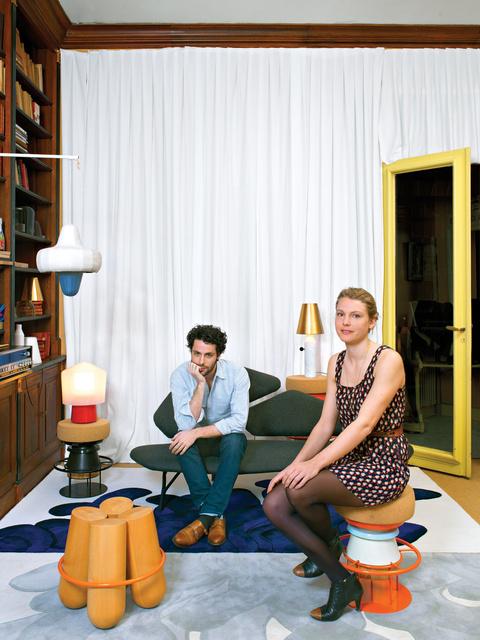
Jean-Baptiste Souletie and Louise Breguet are the young founders of Parisian manufacturer La Chance. They release “unlimited” editions from primarily European designers, like Note Design Studio, whose Tembo and Bolt stools are shown here in their studio space, a flat in the 16th arrondissement. Photo by: Céline Clanet
One of the most intriguing debuts at 2012’s Salone del Mobile in Milan was that of France’s La Chance, who presented a Jekyll & Hyde–themed furniture collection in a split-screen display so that objects on each side “mirrored” each other. Pieces on the refined Jekyll side featured neutral hues, natural materials, and matte finishes, while, on the playful Hyde side, those same pieces were rendered in audacious colors and high gloss. La Chance’s Jean-Baptiste Souletie and Louise Breguet had found an unorthodox way to tell two very different stories through a single object.
One year later, the floor of their Empire-style office—once a swank residential apartment in an early modernist building in Paris—is crowded with latter-day La Chance pieces: Pierre Favresse’s Magnum tabletops (Jekyll), a shiny yellow coffee table by Luca Nichetto (Hyde), and a pair of Note Design Studio Tembo stools (one Jekyll, one Hyde) are framed by a marble fireplace, lofty fabric-draped walls, and an aging wood-paneled library. This mix of classical and avant-garde, timeless and timely, isn’t Manichaean, however; it speaks to the coherent, mutually enriching duality that the two are assuredly creating.
Slideshow
“Creative people like to be challenged. We’re often surprised by an approach we didn’t expect.” —Jean-Baptiste Souletier
These polar qualities are more subtle in La Chance’s second collection, shown at Salone in April: The Jekyll version of Paris-based Pool’s Vulcain lamp is sophisticated, with a Carrara marble body topped by a perforated copper shade. In the lamp’s Hyde incarnation, color is used with restraint: A yellow switch and blue cord accent an otherwise entirely white object.Breguet is an architect. Souletie, ostensibly a businessman, once did an after-hours interior redesign of the London brokerage firm where he worked, and, in the end, was given the budget to complete it. The two, who are distantly related, share creative direction, giving designers precise briefs on materials, production constraints, dimensions, and some style elements. “The more constraints, the better the outcome,” explains Souletie. Beirut-born Parisian Charles Kalpakian’s Rocky credenza, for instance, is a trompe l’oeil that makes a graphical game of its structure and yet has a very straightforward construction.
Slideshow
Noé Duchaufour-Lawrance’s Borghese coffee table has an abstract form that references pine trees in the Villa Borghese park in Rome.
Visible structure is a company signature. Favresse was asked to make a visually light table from heavy elements, so he connected a wooden tabletop to marble legs using a metal cage that became both load-bearing and decorative. American Jonah Takagi’s Tip Top table lamp superimposes two glass domes that touch only at their peaks, where the shade seems to balance in delicate equilibrium. “There’s no concept to explain, no hidden function or symbolism,” says Souletie of La Chance’s tendency to always be two things at once, luxurious and unpretentious, inventive and plainspoken. “You may be surprised by the unusual shape, but you understand how it’s made at first sight. It’s blunt and it’s honest.” —Shonquis Moreno